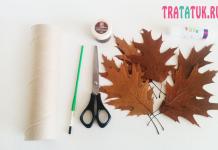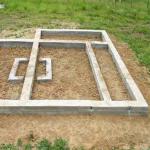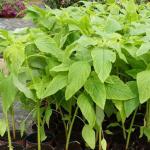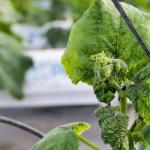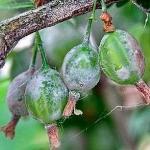Seed propagation in the garden strawberries we are used to, unfortunately, leads to the appearance of less productive plants and weaker bushes. But another type of these sweet berries, alpine strawberries, can be successfully grown from seeds. Let's learn about the main advantages and disadvantages of this crop, consider the main varieties and features of agricultural technology. The information presented in this article will help you decide whether it is worth allocating a place for it in the berry garden.
Often, when we see a beautiful flower, we instinctively bend down to smell its fragrance. All fragrant flowers can be divided into two large groups: nocturnal (pollinated by moths) and daytime, whose pollinators are mainly bees. Both groups of plants are important for the florist and designer, because we often walk around the garden during the day and relax in our favorite corners when evening comes. We are never overwhelmed by the scent of our favorite fragrant flowers.
Many gardeners consider pumpkin to be the queen of garden beds. And not only because of its size, variety of shapes and colors, but also for its excellent taste, healthy qualities and rich harvest. Pumpkin contains a large amount of carotene, iron, various vitamins and minerals. Thanks to the possibility of long-term storage, this vegetable supports our health all year round. If you decide to plant a pumpkin on your plot, you will be interested in learning how to get the largest possible harvest.
Scotch eggs - incredibly delicious! Try to prepare this dish at home, there is nothing difficult in preparation. Scotch eggs are a hard-boiled egg wrapped in minced meat, breaded in flour, egg and breadcrumbs and deep-fried. For frying, you will need a frying pan with a high side, and if you have a deep fryer, then that’s just great - even less hassle. You will also need oil for frying so as not to smoke in the kitchen. Choose farm eggs for this recipe.
One of the most amazing large-flowered tubs of Dominican Cubanola fully justifies its status as a tropical miracle. Warm-loving, slow-growing, with huge and in many ways unique bells of flowers, Cubanola is a fragrant star with a complex character. It requires special conditions in the rooms. But for those who are looking for exclusive plants for their interior, a better (and more chocolatey) candidate for the role of indoor giant cannot be found.
Chickpea curry with meat is a hearty hot dish for lunch or dinner, inspired by Indian cuisine. This curry is quick to prepare but requires some prep. The chickpeas must first be soaked in plenty of cold water for several hours, preferably overnight; the water can be changed several times. It is also better to leave the meat in the marinade overnight so that it turns out juicy and tender. Then you should boil the chickpeas until tender and then prepare the curry according to the recipe.
Rhubarb cannot be found in every garden plot. It's a pity. This plant is a storehouse of vitamins and can be widely used in cooking. What is not prepared from rhubarb: soups and cabbage soup, salads, delicious jam, kvass, compotes and juices, candied fruits and marmalade, and even wine. But that's not all! The large green or red rosette of leaves of the plant, reminiscent of burdock, acts as a beautiful background for annuals. It is not surprising that rhubarb can also be seen in flower beds.
Today, the trend is to experiment with unusual combinations and non-standard colors in the garden. For example, plants with black inflorescences have become very fashionable. All black flowers are original and specific, and it is important for them to be able to select suitable partners and location. Therefore, this article will not only introduce you to an assortment of plants with slate-black inflorescences, but will also teach you the intricacies of using such mystical plants in garden design.
3 delicious sandwiches - a cucumber sandwich, a chicken sandwich, a cabbage and meat sandwich - a great idea for a quick snack or for an outdoor picnic. Just fresh vegetables, juicy chicken and cream cheese and a little seasoning. There are no onions in these sandwiches; if you wish, you can add onions marinated in balsamic vinegar to any of the sandwiches; this will not spoil the taste. Having quickly prepared snacks, all that remains is to pack a picnic basket and head to the nearest green lawn.
Depending on the varietal group, the age of seedlings suitable for planting in open ground is: for early tomatoes - 45-50 days, average ripening periods - 55-60 and late ones - at least 70 days. When planting tomato seedlings at a younger age, the period of its adaptation to new conditions is significantly extended. But success in obtaining a high-quality tomato harvest also depends on carefully following the basic rules for planting seedlings in open ground.
Unpretentious “background” plants of sansevieria do not seem boring to those who value minimalism. They are better suited than other indoor decorative foliage stars for collections that require minimal care. Stable decorativeness and extreme hardiness in only one species of sansevieria are also combined with compactness and very rapid growth - rosette sansevieria Hana. The squat rosettes of their tough leaves create striking clusters and patterns.
One of the brightest months of the garden calendar pleasantly surprises with the balanced distribution of favorable and unfavorable days for working with plants according to the lunar calendar. Vegetable gardening in June can be done throughout the entire month, while the unfavorable periods are very short and still allow you to do useful work. There will be optimal days for sowing and planting, for pruning, for a pond, and even for construction work.
Meat with mushrooms in a frying pan is an inexpensive hot dish that is suitable for a regular lunch and for a holiday menu. Pork will cook quickly, veal and chicken too, so this is the preferred meat for the recipe. Mushrooms - fresh champignons, in my opinion, are the best choice for homemade stew. Forest gold - boletus mushrooms, boletus and other delicacies is best prepared for the winter. Boiled rice or mashed potatoes are ideal as a side dish.
I love ornamental shrubs, especially unpretentious ones and with interesting, non-trivial foliage colors. I have various Japanese spirea, Thunberg barberries, black elderberry... And there is one special shrub, which I will talk about in this article - viburnum leaf. To fulfill my dream of a low-maintenance garden, it is perhaps ideal. At the same time, it is capable of greatly diversifying the picture in the garden, from spring to autumn.
Signs of head maturation
Garlic ripens very evenly. Signs of maturation are:
- yellowing of the lower leaves;
- drying of the outer films and their acquisition of a color characteristic of the variety;
- easy separation of cloves;
- straightening of arrows, previously rolled into rings, in shooting varieties;
- cracking of boxes with bulbs;
- tops lodging.
These signs are an indicator of technical maturity, when the processes of bulb formation are not yet completed and end after harvesting.
Cracking of the heads (physiological maturity) indicates that the cloves are ready to germinate and the crop needs to be harvested urgently. But this is not always a sign of maturity. Often even unripe heads crack when planting garlic after potatoes.
Garlic harvesting time
Harvesting time depends on the method of growing the crop.
The cleaning time is affected by weather conditions. In cold, damp summers, harvest ripening is delayed by 5-10 days.
Garlic cannot be harvested too early, as it will not store well. When harvested late, the heads fall apart into individual cloves. The optimal time comes when the arrows straighten and the inflorescence box begins to open. If there are no arrows, then they focus on the tops: when they fall down, they begin harvesting.
The ripening time of garlic heads can be increased or decreased using various agricultural practices.
Pre-harvest activities to improve crop quality
2 weeks before technical maturity, the arrows straighten, the garlic stops growing, and the bulbs begin to fill. At this time, the leaves are crushed or tied in a knot to enhance the outflow of nutrients from the stems and leaves to the heads. In this case, the ripening period increases by 10-14 days. If the summer is very rainy, then this technique is not used, since long-term exposure of the heads to wet soil leads to them being affected by fungal diseases.
When the inflorescences begin to straighten, the soil from the bulbs is raked halfway so that there is air access to the cloves. It is especially necessary to do this in wet weather. If this is not done, then due to the increased moisture content in the soil, the penetration of air to the roots becomes difficult. The cloves begin to experience oxygen starvation and die as a result. This phenomenon is called soaking. Raking the soil promotes normal respiration of the bulbs and accelerates their formation by 3-5 days.
When to remove garlic from the garden, drying garlic
When the tops fall down and begin to dry, the plants are dug up. You cannot delay harvesting, since mature garlic germinates easily. You can't harvest garlic after it rains. It is unacceptable to pull plants out of the ground, as this can damage the bulb. The dug up heads are left in the air for 5-6 hours so that they ventilate and dry. At night, the harvest is stored in the barn.
Garlic is dried along with the tops for 12-15 days in sheds or attics, laying it out in 1-2 layers. In sunny, dry weather, the boxes are taken out into the open air.
Plants dry very well and quickly in a greenhouse, where there are ideal drying conditions. The boxes with the harvest are placed in a greenhouse and left for 8-10 days. The plants are turned over from time to time so that the lower heads are on top. The greenhouse is left open even at night. Properly dried garlic has an elastic stem that bends well, but does not break.
Plants with arrows are left on the beds for 7-10 days after harvesting the main crop. When the flower stalks begin to turn yellow, they are cut, tied into bunches and dried in the shade for 20-25 days. During this time, the bulbs will fill up, become much larger and acquire a color corresponding to the variety.
Preparation for storage
At the end of drying, the bulbs are cleared of soil, the roots and stems are cut off and stored.
Clearing the ground consists in removing 1-2 layers of integumentary scales. You should not remove more layers, as they protect the head of garlic from excess moisture evaporation during storage. If you remove too many scales, then after 1-2 months the cloves will begin to dry out.
Root pruning. The roots are cut at a distance of 2-5 mm from the bottom, and the remaining ends are singed. This prevents the cloves from sprouting during storage and the heads being damaged by barn pests. The roots of the seed material are not burned.
Tops trimming. Dry tops are cut off, leaving a neck of 2-3 cm. If the garlic is stored in braids, then 30-40 cm of the stem are left, if in bunches - then 15-20 cm.
Peduncles with aerial bulbs are tied into bunches and stored separately.
General rules for storing garlic
Ideally dry bulbs are stored for storage. They are stored in a dark place at a temperature of 3 to 22°C and a humidity of no more than 70% in places where there is no strong air circulation.
Methods for preserving crops in a private house and in a city apartment are different. Garlic is best stored at low positive temperatures (3-6°C) in a cellar or attic where conditions are close to optimal.
In apartments, the crop is preserved well at 18-22°C in a closed space without drafts. Bulbs should not be stored in rooms with high humidity (kitchens, bathrooms) or in places where the air temperature is above 22°C (near radiators, on cabinets, mezzanines). The most suitable place is the bottom shelves of cabinets in the hallway or pantry, where the temperature and humidity are not too high.
It will not be possible to store garlic in the refrigerator even if you want to, since the humidity there is very high. The heads quickly become damp and rot or mold. The maximum shelf life of garlic in the refrigerator is 7-10 days.
Cracked heads will last no more than a month. Since the cloves are not protected by a common integumentary scale, the process of respiration and evaporation is very intense, and they dry out quickly. They must be used first.
The shelf life of winter garlic is 6-8 months (depending on the variety), spring garlic - 8-10 months. During this period, the bulbs are immersed in a state of natural biological dormancy. At the end of the dormant period, metabolic processes in the cloves intensify, preparing for the beginning of the growing season. Therefore, the greatest difficulties arise in the second half of the crop’s shelf life. At this time, the heads are stored either at a temperature of 0-2°C (garlic germinates at +3°C), or at +20°C and above (if the temperature is too high, the germination of the cloves slows down).
How to store garlic
There are several ways to preserve garlic:
- in braids, wreaths, buns;
- in nets and baskets;
- in linen bags;
- in boxes, boxes;
- in banks.
It is good to store garlic in braids, bundles, baskets, nets if you have a barn, attic or at least a dry basement. Storage in jars is suitable for apartments. Other storage methods are suitable for both a private house and an apartment.
Storing garlic in braids.
This is the most common way to preserve garlic. Braids take up little space, and it is easier to control the occurrence of spoilage with this storage method.
When storing in braids after drying, leave 30-40 cm of tops. To weave a braid, you need a strong thin rope, twine or flexible wire.
Braiding technique.
Take 3 heads and tie them at the base with a rope. This results in four ends: three stems and a rope, which, when weaving, must always be intertwined with one of the stems.
Make the initial binding.
Then, after each weave, a new head is added to the braid.
The braids should not be very long, otherwise they will break under their own weight. You can braid garlic like a wreath, twisting the stem around the neck of the previous head. Store braids and wreaths in sheds at a temperature of 3-6°C or in an apartment closet (at 18-22°C). But in an apartment, garlic braided into braids does not last long. To prevent braids and wreaths from falling apart, the heads are not pulled out along with the tops, but cut off, then the stem remains inside and the braid does not fall apart.
You can simply tie the heads into a bunch of 15-20 pieces and hang them in the barn or attic. You cannot hang braids in the kitchen for long-term storage.
Storage in baskets and nets
The bulbs are laid in 3-4 layers; if there is high humidity in the storage room, then they are sprinkled with onion peels. The baskets are placed in a dark place, the nets are hung on the wall. The crop is preserved better in baskets than in nets.
Storage in linen bags
Garlic is placed in bags made of natural fabrics and sprinkled with salt to protect it from moisture. The bags are placed on pallets or the bottom shelves of boxes close to each other.
Storage in boxes and boxes
Boxes and crates should have holes to allow for slight air circulation. The garlic is laid out in 3-4 layers; in rooms with high humidity, each layer is sprinkled with salt. The top layer of the heads is covered with 1-2 cm of salt. Salt absorbs excess moisture and prevents the heads from rotting and molding.
Storing garlic in a jar with salt.
Storing garlic in jars
Unpeeled garlic is placed in glass jars. Small onions are placed whole, large ones are divided into cloves. The jar is closed with thick paper or a perforated nylon lid. This is the best way to preserve garlic in a city apartment.
Storing bulbs
If the seeds are sowed in the spring, then the dried arrows with bolls are tied into bunches and stored in a barn at 2-4 °C. In the apartment they can be stored on an insulated balcony. Place gauze bags over the inflorescence to prevent the bulbs from falling off. 2 months before planting, aerial bulbs are separated from the peduncle, cleaned of impurities and stored in bulk at a temperature of 12-15°C.
Additional means used for storing garlic
In addition to the above, there are other ways to preserve crops, but they are used relatively rarely due to their labor intensity.
| Storage method | Description | Advantages | Flaws |
| In cling film | The head is wrapped tightly in cling film. The rest of the stem is left open, through which the bulb breathes | Prevents the cloves from drying out. | Closer to spring, when breathing intensifies, rot may appear |
| In paraffin | The head is lowered into melted hot paraffin, then the excess liquid is allowed to drain, dried and put into boxes. | The film formed on the surface prevents the evaporation of moisture, the cloves do not dry out and remain fresh and juicy until spring. This method reliably protects the head from fungal diseases. | The method is very labor intensive |
| In flour | Lay the garlic in layers, sprinkling each layer with flour. | Flour absorbs excess moisture. | Very expensive storage method |
| In the ash | The bulbs are laid in layers, sprinkled with ash. The top layer of heads is completely covered | Ash reliably protects from excess moisture and does not impede the normal breathing of the bulbs | Not every person would risk covering garlic with ash. |
The main goal with any storage method is to preserve the juiciness and freshness of the cloves for as long as possible and to prevent damage to the harvest.
Possible problems when storing garlic
Main problems encountered during storage:
- molding and rotting of heads;
- drying of the cloves;
- color change;
- germination;
- damage by barn pests (root and flour mites).
Mold and rotting of the crop occurs due to increased air humidity. It is necessary to sort, remove damaged bulbs, dry the rest for 5-6 days near a radiator or on mezzanines and put them in a dry room. If the air humidity is high, then sprinkle the remaining garlic with salt.
Drying garlic cloves. In winter varieties, natural drying occurs towards the end of the storage period. It can be slowed down for several weeks by wrapping the heads in cling film. If the garlic begins to dry long before the end of the period, then the reason is too dry air. The heads can be placed in the refrigerator for several days, where the respiration processes slow down. But you don't need to keep them there for too long, otherwise they will become damp and rot. To prevent further drying, the bulbs are treated with paraffin or wrapped in cling film.
Changing the color of the teeth at the base turns yellow, indicating damage by a stem nematode. In summer, the pest lays eggs in the bottom of plants and the soil around them. Garlic infected with nematode eggs does not store well. They sort it out, separate the diseased heads from the healthy ones and burn them. All seed material, even if no pest damage is detected in it, must be treated with an insecticide, then dried and continued to be stored under the same conditions.
Germination. The cloves that begin to sprout are cleaned and filled with vegetable oil. In this form they can be stored for a very long time. You can cauterize the bottom with fire, but if the process has already begun, then it cannot be stopped. Sprouted cloves lose their firmness and elasticity and are unsuitable for consumption.
Damage by barn pests is extremely rare. Garlic is mainly affected by root and flour mites. Pests penetrate the clove through the bottom and feed on its juices. The bottom gradually becomes rotten and falls off. If there is a risk of infection, sprinkle the garlic with powdered chalk during storage. If infection is detected during storage, the heads are placed in an oven preheated to 100°C for 1-1.5 minutes. After this, the bulbs are sorted, those affected by mites are selected and burned.
There are several ways to preserve garlic. This way you can avoid significant problems and determine which storage method is best.
When garlic can be harvested depends on the time it was planted, the weather and when the harvesting took place. Experienced gardeners determine the timing of garlic harvesting purely intuitively. For those who have no experience, there is good advice: periodically, starting from the first days of July, once a week, dig up several heads in different places in the bed and carefully inspect them. The very appearance of the garlic will help determine whether it is time to harvest it. Good garlic has a formed, elastic head; the lower leaves should be slightly yellow. If you wait out this moment, then it will be problematic to remove the garlic, and it will also be very inconvenient to prepare it for the winter.
Determining the optimal harvest time
The possibility of long-term preservation of garlic without compromising its commercial properties directly depends on the time of harvest. The harvesting campaign regime is set taking into account the characteristics of the growing season of the crop in the given climatic conditions.
The maximum growth of the ground head occurs during the initial period of drying of the lower leaves. A responsible task for a farmer who wants to harvest a rich and high-quality harvest is to accurately determine the optimal harvest period, after which it is possible to organize successful storage of garlic for the winter.
- If harvested too early, the garlic may ripen, but the bulb will not have time to grow to its maximum possible size. In this way, you can lose up to 15% of the potential yield.
- When harvesting is late, the garlic has time to overripe. The top husk will begin to peel off and crack, allowing the cloves to fall out of the bulb, dry out and spoil. This will lead to a decrease in shelf life and marketability, a decrease in the cost and demand for products, and a sharp drop in profits from sales.
The harvest date is determined by the external characteristics of the plant:
- for non-shooting varieties - by lodging of false stems;
- for bolting varieties - by wilting of the upper leaves, cracking of the covering layer of the inflorescence, drying out of the outer shells of the garlic head.
When to dig up winter garlic
Winter garlic is dug from the 20th of July until the beginning of August. You must first make sure of maturity; the signal is massive yellowing and lodging of the lower leaves, this means that winter garlic is ripe and ready for harvesting. All the nutrients from the above-ground part have passed into the head, so there is no longer any need to leave the garlic in the ground.
If you are in doubt whether the garlic is ripe or not, dig up a couple of bulbs with a fork and inspect. Good garlic that has reached its required ripeness is firm to the touch, the cloves will be well separated (but not falling apart), and the scaly shell will come off easily.
In addition, the ripening of garlic can be calculated by the arrows, at the ends of which the seed pod with bulbs is ripening; when it begins to open, it means it’s time to dig up the garlic in the garden. Bulbs can come in handy if you want to improve the health of your plantings. The teeth gradually, year after year, accumulate infections from which the bulblets are free. 
No need to wait for complete drying, otherwise you will miss the deadline.
When to dig up spring garlic
The second name for spring garlic is summer. It begins to ripen at the end of August, towards the beginning of September. When you observe yellowing of the stems and leaves, you can be sure that the garlic is ready for harvesting. The root collar dries out, the bulb is hard and dried out. All these are signs of mature spring garlic.
But, if you do not have specialized equipment, then it is quite possible to do the cleaning by hand. It is necessary to cut off the arrows, dig up the bulbs a little and carefully, avoiding injury, remove the garlic from the ground. The harvest is laid out in rows so that it dries within 24 hours. Then it is collected in a special room, where it is additionally dried for several weeks with the stems and roots already cut off. It is recommended to leave at least a centimeter of the stem, and when cutting the roots, do not damage the bottom.
If you miss the deadline, the bulbs gradually begin to crack and the cloves fall apart. Then they just start to sprout. The time when garlic should be harvested is determined by several criteria. A dense shell has formed around the heads and the teeth themselves have quite clear outlines. As for the above-ground parts, you should notice yellowing of the two lower leaves.
How to properly remove garlic
Garlic is ready to harvest when its leaves turn yellowish-brown and begin to fall off. Another sign of maturity is dry leaves. Garlic harvested too late will not store well, and the head will disintegrate into individual cloves that are poorly covered with husk. This type of garlic is more susceptible to disease. They dig garlic in clear, dry weather, digging in the bulb and pulling it out of the soil by the tops. Please note that garlic on any soil is not pulled out, but dug up! You need to carefully remove the garlic from the garden so as not to damage the heads. Now collect the garlic, remove the soil from the roots and bulbs with your hands and lay it out to dry for 1 -1.5 weeks. After thorough drying, the roots of the garlic are cut off, leaving no more than 2-3 mm, and the stem, leaving a neck up to 10 cm long. When the heads are dry, they are cleaned of dirt and transferred to a well-ventilated, bright room. You should not hit the dug out heads with a shovel or other hard object: any dent on the teeth can eventually turn into a source of rotting. Afterwards, you need to carry out the first selection of heads for seeds, trying to choose the largest and most beautiful ones. Selected heads are tied into bundles of 10 pieces. and hang it separately from the rest of the garlic, also tied in bunches, on a rope in the same place. Do not tear off the tops: the garlic should dry along with the leaves. It is better to remove garlic 5 days earlier than 5 days later. With early harvesting and dosing of bulbs under a canopy, the outflow of nutrients from the leaves into the bulbs continues for 5–10 days. At the same time, their mass and density increases, 3-4 integumentary scales of good quality are formed. 
If harvesting is delayed even by 2-3 days, the integrity of the integumentary scales is compromised, the cloves crumble, and the bulbs become loose and unsuitable for storage.
Latest articles about gardening
Storing garlic after harvesting
Immediately after harvesting garlic, it should not be stored for storage. You should first dry it for a couple of weeks, and only then store it for storage. As a rule, they braid their hair or simply put the bulbs in boxes. After a week, you should cut off the roots and tops by 1/2 or 3/4 of each garlic, and pour them into clean canvas bags, then dry them well for 10–12 days, then store them. Spring garlic, unlike winter garlic, is remarkably stored in both warm and cold rooms. A popular storage method is braided braids of garlic, which are hung in the kitchen - it is not only convenient, but also beautiful. Store in a cool, dark place, allowing air to move freely around the bags.
If garlic will be stored in an apartment for the winter, it must be kept in a cool corner, otherwise the heads will turn yellow. When storing root vegetables for a long period of storage, trim the stems, leaving only 5 cm from the tuber. If storage is planned in a basement or refrigerator, the temperature must be maintained at +1-50C
Garlic is grown in every garden.
Some people like winter, and some like spring.
Winter crops are planted before winter, spring crops are planted in spring.
This is explained by the poor keeping quality of winter garlic due to the smaller number of scales.
Harvesting of winter garlic begins 100-110 days after emergence, spring garlic is harvested 14-20 days later, i.e. already towards the end of July you need to monitor the development of the needle.
If you miss the moment of collection, the head of garlic will disintegrate into cloves and long-term storage will no longer be possible.
Signs of readiness for digging garlic

Winter garlic is dug up when the lower leaves begin to turn yellow, the inflorescences crack and the tops begin to lode. If it is untimely, this indicates other problems.
At this time, in non-shooting varieties of garlic, the leaves also turn yellow and the root collar becomes soft.
In different places, scrape off the soil from several heads of garlic and check the condition of the scales; they should be tight and strong.
Harvesting garlic
It is best to dig up garlic in dry weather, resistant to rain. When digging with a shovel or pitchfork, try to injure the roots as little as possible.
Place them in rows on burlap, covering them with leaves for 3-4 days. During drying, the garlic heads will not get sunburn, but will increase resistance to diseases and the destruction of various nematodes and bacteria.
At night, bring the crop under a canopy. Remove the soil from the roots by hand, without shaking them off or beating them on the ground (there will be bruises), so as not to shorten the shelf life.
Cut off the tops, leaving a stem 10 cm long and roots no more than 3 mm long.
If there are prolonged rains and the time for harvesting garlic is coming to an end, do not hesitate, dig it up and dry it for 7-10 days in a room with ventilation and an air temperature of 25°C, gradually increasing the air temperature to 40°C.
Garlic storage
Carry out crop culling and sorting. Small garlic spoils faster than large ones.
The ideal way to store garlic is in. It is better to “weave” no more than 15 onions into one braid, tying them with twine.
You can also store it in nylon stockings, boxes (layer no more than 15 cm), baskets (dry and breathable).
Spring garlic is stored at a temperature of 16-20ºС and a humidity of 50-70%, winter garlic at a temperature of 2-4ºС and a humidity of 70-80%.
- In a glass container: mix garlic with salt.
- In paraffin: cut the roots, stem to 3 cm, remove the top scales and dip in warm paraffin.
If the garlic is not intended for future planting, then scorch the roots over a candle flame and put them in baskets.

- Drying. The reason is the evaporation of moisture. The solution is waxing. Melt the paraffin and lower the head of garlic.
- Mold. The reason is damaged heads, high air temperature and high humidity. The solution is to dry the garlic well in the open sun before storing it to kill all pathogenic bacteria.
- Germination. The reason is long-term storage. The solution is burning. Burn the bottom of the garlic head a little over a gas burner.
Garlic is a plant equally loved by chefs, doctors and gardeners. It is not difficult to grow, it does not require any special conditions, and it grows both in winter and summer. Proper harvesting of garlic and its subsequent preservation can allow you to enjoy the harvest for a long time.
Winter garlic is the one that is planted for the winter. It is usually harvested one hundred days after shoots appear above the ground. If we translate this into the numbers we are used to, then winter crops should be harvested at the end of July and at the beginning of August.
It is worth proceeding to collection when the lower leaves have dried, and the upper ones have turned a little yellow, the shells of the aerial bulbs have burst, and seeds - bulbs - can be seen in them. It is recommended to dig up only fairly large heads, or it is better to sort them during the transition to preserving preparations for planting.
The main thing is to carefully monitor that your bulbs do not break into cloves too easily - this is a sign that the plant is already overripe.
A garlic harvester will help you speed up the harvesting process and improve its technology. This machine removes the bulb from the soil along with the stem, clearing it of clods of earth. Preserving the tops for long-term storage, she ties the garlic into bunches and unloads them with a roller for ease of subsequent collection.
When to dig up spring garlic
The second name for spring garlic is summer. It begins to ripen at the end of August, towards the beginning of September. When you observe yellowing of the stems and leaves, you can be sure that the garlic is ready for harvesting. The root collar dries out, the bulb is hard and dried out. All these are signs of mature spring garlic.
But, if you do not have specialized equipment, then it is quite possible to do the cleaning by hand. It is necessary to cut off the arrows, dig up the bulbs a little and carefully, avoiding injury, remove the garlic from the ground. The harvest is laid out in rows so that it dries within 24 hours. Then it is collected in a special room, where it is additionally dried for several weeks with the stems and roots already cut off. It is recommended to leave at least a centimeter of the stem, and when cutting the roots, do not damage the bottom.
Storage rules
Storing garlic is not much different from storing all other crops. It is necessary to avoid high humidity in the room to prevent the development of fungus or mold. The acceptable rate is from forty to fifty percent. It is necessary to ensure that there is normal ventilation in the room. Due to the fact that large bulbs are best stored, it is recommended to sort the crop by size before storing it.
At home, this vegetable is stored in braids or wreaths, fifteen or seventeen onions each. An alternative to this method is storing in bunches, or small brooms. Tying the bulbs into small panicles, they are hung from the ceiling, choosing the least humid corner.
Video “When and how to harvest garlic”
In this video you will learn everything about harvesting garlic.

